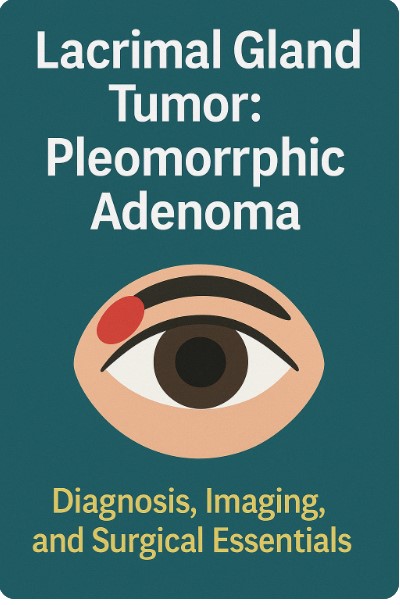Tistoryview
Disease&Treatment/Oculoplastics
Diagnosis, imaging findings, and surgical treatment of benign lacrimal gland tumors, pleomorphic adenomas
eye_doc 2025. 4. 20. 15:29👁 Pleomorphic Adenoma – The Most Common Benign Lacrimal Gland Tumor
Lacrimal gland tumors are rare orbital lesions, accounting for only 10% of orbital masses.
Among them, pleomorphic adenoma is the most frequent benign epithelial tumor arising directly from the lacrimal gland.
It typically occurs in adults in their 40s to 50s, with equal gender distribution, and tends to grow slowly and painlessly.


✅ Clinical Features
- Painless and slow-growing orbital mass
- Located in the superotemporal orbit
- May cause inferomedial displacement of the globe
- Proptosis may be present in larger masses
- Usually develops over months to a year
✅ Radiologic Findings (CT/MRI)
- Well-defined, round or oval mass
- Indents the globe without infiltrating it
- May cause smooth bony erosion of the lacrimal fossa
- MRI may incidentally detect the tumor during unrelated evaluation
The well-circumscribed nature is due to a pseudocapsule surrounding the mass –
a hallmark of benign behavior.
✅ Diagnosis and Treatment
- Diagnosis can be made without biopsy due to classic radiologic appearance
- Biopsy is discouraged to prevent pseudocapsule disruption
- Treatment is complete surgical excision via lateral orbitotomy
- If pseudocapsule is violated, there's up to 30% recurrence
and ~20% chance of malignant transformation over decades
✅ Summary Table
FeatureDescription
| Location | Superotemporal orbit (lacrimal gland fossa) |
| Symptoms | Painless mass, globe displacement |
| Imaging | Well-circumscribed, non-invasive |
| Treatment | Complete excision without capsular rupture |
| Risks | Recurrence if incomplete removal; malignant transformation possible |
